
Sustainable Wildlife Experiences in Sri Lanka: Explore, Conserve, and Cherish
More often than not, the more common reference to Sri Lanka is indeed the Pearl of the Indian Ocean, and for good reason. The diverse ecosystems range from rainforests teeming with endemic species to coral reefs that are equally as teeming. There’s so much beauty beneath this fragile balance that begs for protection and care. Let’s look in to how you could see great wildlife in Sri Lanka on a sustainable note that will ensure its protection for times to come.
Sri Lanka’s diverse ecosystem: A wonderland for wildlife
Because Sri Lanka is located at the conjuncture of two biodiversity hotspots, it has been bestowed with tremendous ecological diversity. A snapshot of some of nature’s greatest treasures that adorn the island follows below:
Rainforests: The Sinharaja Rainforest is a UNESCO World Heritage Site biodiversity hotspot where very rare plants and animals live together.
Grasslands and Dry Zones: Yala and Udawalawe rank among the national parks where elephants, leopards, and lots of other species are found.
Wetlands and Lagoons: These places are a hot spot for migratory birds from all parts of the world, and the places which are especially notable are Bundala and Kumana.
Coral Reefs and Oceans: Off Sri Lanka’s coastline is home to coral gardens, sea turtles, and even the mighty blue whale.
Understanding these ecosystems helps travelers appreciate their fragility and the importance of sustainable tourism.
Ethical Safaris: Witnessing Giants of the Wild
Sri Lanka’s national parks offer world-class safari experiences. However, overcrowded and poorly managed tours can harm wildlife. Here’s how to make your safari truly ethical:
Choose Small-Group Tours: Smaller groups mean less noise and disturbance for animals.
Morning or Evening Safaris: These tours take place during the peak time of animal activities, so you will most certainly get the best sightings without causing much disturbance to the animals.
Certified Guides: Make use of operators trained in conservation ethics and take them around without intruding into their habitat.
The main inclusions are listed below:
Behold one of the world-famous elephant gatherings around Minneriya, the Great Elephant Gathering.
Observe the leopard that is stealthy in Yala or Wilpattu; patience and respect can do wonders sometimes.
Birdwatching Bliss: A Paradise for Ornithologists
Sri Lanka is a haven for bird watchers, housing over 430 species of birds, out of which 33 are endemics. For the bird lovers:
Top Spots: Sinharaja Rainforest, Horton Plains, and Muthurajawela Marsh.
Species Identification: colorful Sri Lanka junglefowl, the rare blue magpie, and flocks of flamingos during migration.
Birding Etiquette: Refrain from playback calls so as not to stress birds. Make quiet observations from a distance.
Ocean Safaris: Securing Giants of the Ocean
The waters of Sri Lanka are a playground for the marine, and tourism imposes many challenges of coral bleaching, pollution, and overfishing. Here is how to go about sustainable ocean activities
Whale Watching: Tours from Mirissa or Kalpitiya must be carried out by operators who will respect strict guidelines—no chasing, no harassment, no crowding of the whales.
Snorkeling and diving: Use operators that follow the guidelines for preserving the reefs. Never touch the coral or any marine animal.
Sea Turtle Hatcheries: Take part in those hatcheries that release their hatchlings into the wild, rather than keeping them captive.
Imagine a blue whale breaching or swimming with manta experiences even more rewarding if done in an ethical manner.
Community-Driven Eco-Tourism: People and Nature Unite
It is not all about nature in sustainable tourism; it is about the people, too. In Sri Lanka, eco-lodges and community-based initiatives ensure that meaningful interaction with the locals occurs. Accommodation in sustainable material with solar-powered and waste recycling systems. Guided tours through rural Sri Lanka
Local Cuisine: Try meals prepared with organic, locally sourced ingredients—often the freshest and tastiest way to dine.
Your visit supports livelihoods and strengthens conservation efforts, creating a ripple effect of positive change.
Volunteer for Wildlife: Be Part of the Solution
Want to make your trip truly memorable? Join a conservation project and leave a lasting impact.
Turtle Conservation: Protect the nests of turtles from predators and poachers along the southern coast.
Elephant Rehabilitation: Join centers working for the rehabilitation of elephants from captivity.
Coral Reef Restoration: Go diving to plant coral fragments for the restoration of the reef.
These tours allow not only going back but also going in-depth with the conservation challenges in Sri Lanka.
Travel Tips for Lighter Footprints
Responsible travel doesn’t start and stops with responsible tour choices.
Here are some daily habits which contribute to making a difference as well:
Reusable products brought: water bottle, straw made of metal and a cloth bag in order not to use single way plastics.
Eco-friendly packing includes toiletries that are biodegradable and reef-safe sunscreens.
Respect to Nature: stick to trails and keep a safe distance while observing animals. Feeding is strictly prohibited.
Why Sustainable Tourism Matters
Sustainable wildlife tourism in Sri Lanka is not a trend, but rather a necessity. Every decision made acts like an instrument in this orchestra that:
1. Protects Fragile Ecosystems: From jungles to coral reefs, your actions ensure these are preserved.
2. Supports Local Communities: Spending becomes the fuel for eco-tourism and conservation projects.
3. Preserve Wildlife for Generations: It ensures that future generations of travelers will also get a glimpse of such wonders.
Sri Lanka Awaits: Will You Answer Nature’s Call?
Smell the golden sunsets while tracking leopards and releasing baby turtles into waves—Sri Lanka is a destination that offers experiences enriched with magic. And when you travel more sustainably, you make sure stories about its wildlife will live on for generations.
So pack your curiosity, your respect for nature, and your sense of wonder, Sri Lanka’s wild heart is waiting to meet yours.


